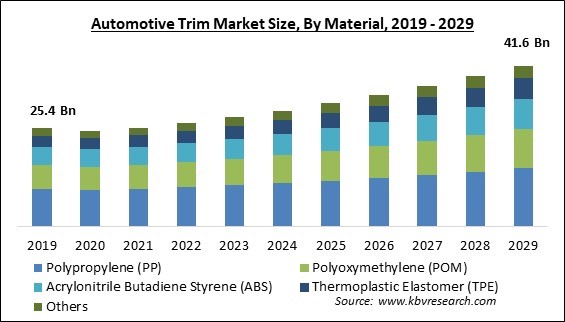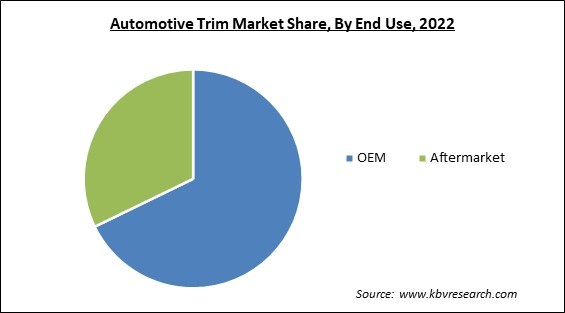The Global Automotive Trim Market size is expected to reach $41.6 Billion by 2029, rising at a market growth of 6.6% CAGR during the forecast period.
Automotive trims are plastic parts fitted in cars to give them a better appearance and more features. Its trims describe the distinctive elements of a car. Many parts, like dashboards, rear & front bumpers, and similar ones in a car, specify various trims used more often in cars. Numerous automobile component makers have created and produced strong, lightweight components comprised of various polymers. Because these parts are used more frequently in cars, the market for automotive trim is growing.

Germany, China, India, the U.S., Japan, and the U.K. have all seen significant expansion in their automotive industries during the past ten years. The United States, Japan, and Germany were initially the industrialized countries on which the world’s automotive industry concentrated. However, because of the rise in demand for cars and automotive parts in these nations, businesses have moved their manufacturing operations there.
Low labor costs allow manufacturers to produce more products at lower costs, which helps them meet rising demand, which is expected to increase car sales over the projected period. The sales of such vehicles are also anticipated to be boosted by the price decline of electric vehicle components, including batteries, transmissions, and alternators. These elements are anticipated to help the global automotive sector expand.
Due to the lockdown that also affected the production of automotive trim, the world's automotive sector was at a standstill during the pandemic. On the other hand, the revenue of the automobile trim market has been impacted by the declining customer demand for vehicle trim. Suppliers of automotive parts throughout the world relied heavily on migrant labour. However, the workers' tardiness foresees a delay in the recovery following the lockdown. Original Equipment Manufacturers in the automotive sector also faced several challenges as a result of the product supply chain disruption.
Trims are crucial for increasing comfort and luxury in a car's interior while lowering vibrations. Traditionally, steel or steel alloys, especially stainless steel, and carbon steel, were used to make trimmings. These materials were heavier and less strong than other materials, though. Thus, technical developments in the automobile sector have resulted in the development of lightweight automotive materials like carbon fiber and various polymers to manufacture trim components.
The need for cutting-edge automotive trims is rising due to rising luxury vehicle sales worldwide, such as sedans and convertibles, which has fuelled the market's expansion. In addition, the need for exterior & interior trim pieces has increased due to the rising demand for passenger automobiles brought on by the developing world's rapid population expansion and rising disposable incomes. As a result, the deployment of interior trim solutions is soaring, which has energized the market's expansion as consumers choose cars with improved comfort and safety.
Numerous components that are placed in a vehicle are more expensive, and as a result, regular replacement of these components is not an option. As a result, producers of passenger cars are equipping vehicles with components that are more robust, long-lasting, and cost-effective. These components can withstand any temperature or weather condition. Additionally, the high cost involved with the replacement of components leads to a rise in the cost of cars, which is projected to hinder market growth.
By material, the automotive trim market is segmented into acrylonitrile butadiene styrene (ABS), polypropylene (PP), polyoxymethylene (POM), thermoplastic elastomer (TPE), and others. The polyoxymethylene (POM) segment covered a considerable revenue share in the automotive trim market in 2022. The automobile industry can employ polyoxymethylene (POM) because of its rigidity, stiffness, and yield strength. Furthermore, it is a preferred polymer for use in the automotive industry to create various components, including several trims, due to its strong chemical & fuel resistance and other qualities.

Based on application, the automotive trim market is bifurcated into external and interior. In 2022, the exterior segment registered the maximum revenue share in the automotive trim market. The global demand for automotive exterior trim elements is expanding rapidly due to consumer demand for more luxury, comfort, and quieter automobile interiors. In addition, the growth of developing countries’ economies and advancements in automotive technology are predicted to cause luxury car sales to increase, thereby leading to market expansion.
On the basis of exterior type, the automotive trim market is divided into bumpers, door & window seals and others. In 2022, the bumpers segment dominated the automotive trim market with the maximum revenue share. Bumpers surround the car's hood, trunk, grill, gasoline, exhaust, and cooling systems to keep them all safe. Because they are comprised of aluminum, steel, rubber, or plastic, they act as shock absorbers and safeguard the car. Due to these features, manufacturers may construct robust bumpers that help the market grow in this segment.
Based on interior type, the automotive trim market is fragmented into dashboard, door panel, and others. In 2022, the dashboard segment witnessed the largest revenue share in the automotive trim market. The vehicles' dashboards are equipped to perform several tasks, including displaying the meters. In addition, they promote the segment's market expansion by being utilized to outfit dash cameras or other components. The automobile industry is significantly impacted by advancements in vehicle dashboards and their materials since modern dashboards must be environmentally friendly and devoid of dangerous elements.
Based on end-use, the automotive trim market is categorized into original equipment manufacturers (OEMs), and aftermarket. The aftermarket segment projected a prominent revenue share in the automotive trim market in 2022. The aftermarket supplier replaces outdated parts in existing cars or fixes a broken portion of a car. Customers desire to upgrade their vehicles with cutting-edge components to improve driving safety, which has led to the aftermarket becoming increasingly popular for automotive trim services.
By vehicle type, the automotive trim market is bifurcated into ICE passenger vehicle, ICE commercial vehicle, battery electric vehicle (BEV), hybrid electric vehicle (HEV), and plug-in hybrid electric vehicle (PHEV). In 2022, the ICE passenger vehicle segment registered the maximum revenue share in the automotive trim market. Compact cars, sedans, hatchbacks, luxury sedans, and other vehicles with internal combustion engines are included in the ICE passenger vehicle segment. The growth of the ICE passenger vehicle segment is facilitated by various automakers' development of electric vehicles.
| Report Attribute | Details |
|---|---|
| Market size value in 2022 | USD 26.8 Billion |
| Market size forecast in 2029 | USD 41.6 Billion |
| Base Year | 2022 |
| Historical Period | 2019 to 2021 |
| Forecast Period | 2023 to 2029 |
| Revenue Growth Rate | CAGR of 6.6% from 2023 to 2029 |
| Number of Pages | 347 |
| Number of Table | 640 |
| Report coverage | Market Trends, Revenue Estimation and Forecast, Segmentation Analysis, Regional and Country Breakdown, Companies Strategic Developments, Company Profiling |
| Segments covered | Material, Application, End Use, Vehicle Type, Region |
| Country scope | US, Canada, Mexico, Germany, UK, France, Russia, Spain, Italy, China, Japan, India, South Korea, Singapore, Malaysia, Brazil, Argentina, UAE, Saudi Arabia, South Africa, Nigeria |
| Growth Drivers |
|
| Restraints |
|
Region wise, the automotive trim market is analyzed across North America, Europe, Asia Pacific, and LAMEA. In 2022, the Asia Pacific region led the automotive trim market by generating the highest revenue share. This is mostly caused by the rising disposable incomes, expanding urban population, and expanding manufacturing operations in many Asian nations. The expansion of the Asia Pacific automotive trim market is also being aided by the always-growing desire of automakers to increase quality by lowering unpredict ableness and eliminating flaws to improve comfort and assistance.
Free Valuable Insights: Global Automotive Trim Market size to reach USD 41.6 Billion by 2029
The market research report covers the analysis of key stakeholders of the market. Key companies profiled in the report include International Automotive Components (IAC) Group, Continental AG, Fritz Dräxlmaier GmbH & Co. KG, Gemini Group, Inc., TS TECH Co., Ltd., Gronbach Inventive Sales & Marketing GmbH & Co KG, Grupo Antolin Irausa, S.A., Kasai Kogyo Co., Ltd., Toyota Boshoku Corporation, Trinseo PLC
By Material
By Application
By End Use
By Vehicle Type
By Geography
The Market size is projected to reach USD 41.6 Billion by 2029.
Increased Sale of Passenger Vehicles are driving the market in coming years, however, High Cost of Replacement restraints the growth of the market.
International Automotive Components (IAC) Group, Continental AG, Fritz Dräxlmaier GmbH & Co. KG, Gemini Group, Inc., TS TECH Co., Ltd., Gronbach Inventive Sales & Marketing GmbH & Co KG, Grupo Antolin Irausa, S.A., Kasai Kogyo Co., Ltd., Toyota Boshoku Corporation, Trinseo PLC
The OEM market acquired maximum revenue share in Global Automotive Trim Market by End Use in 2022; thereby, achieving a market value of $27 billion by 2029.
The Polypropylene (PP) market is leading the Market by Material in 2022; thereby, achieving a market value of $15.2 billion by 2029.
The Asia Pacific market dominated the Market by Region in 2022; thereby, achieving a market value of $16.3 billion by 2029.
Our team of dedicated experts can provide you with attractive expansion opportunities for your business.

